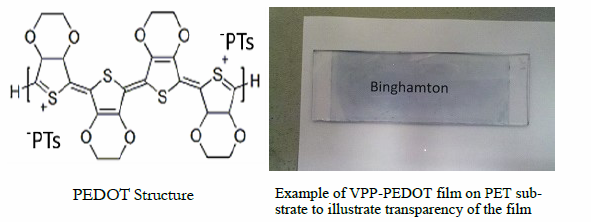Vapor Phase Polymerized Conductive Poly(3,4-ethylenedioxythiophene) Thin Films
Transparent, stretchable, reliable poly(3,4 ethylenedioxytho-pene) materials for Conductive films with high conductivity and transmittance
In addition to favorable conductivity, this material affords the resulting conductive films with other characteristics (e.g., transparency) that make the films amenable to the wide range of applications. ITO is, however, a product of indium, which is a raw material in relatively short supply and, accordingly, continues to in-crease in price with demand growth for thin, conductive films. Moreover, although favored for certain characteristics, films that utilize ITO can suffer from cracking and brittle failures when subject to bending.
This feature some-what limits use of these ITO-based films in combination, e.g., with flexible substrates.The present technology addresses concerns with ITO-based films to provide candidate materials for use in connection with flexible electronics, and encompasses films and material layers comprising poly(3,4 ethylenedioxytho-pene) (PEDOT). The PEDOT film is made utilizing vapor phase polymerization (VPP) with defined parameters and components. The crystalline structure is favorably organized for films to achieve conductivity in excess of 1000 S/cm, and thus suitable for use as a replacement for ITO-based films.

- High Conductivity: in excess of 1000 S/cm, well-above most conventional technologies. Conductivity can be tailored based on the application
- Transmittance: exhibits excellent transmission in excess of 85%
- Reliability: outperforms both PEDOT:PSS and ITO in fatigue test of flexure dimension
- Transparency: optically transparent and/or exhibits optical properties that transmit light through > 90%
- Stretchability: very stretchable, conductivity increases upon stretching
- Consumer Electronics (e.g. phones, televisions, tablet computers, etc.)
- Enhancement of solar cells and light-emitting diode (LED) devices
- Anti-static coatings
Patent Information:
| App Type |
Country |
Serial No. |
Patent No. |
Patent Status |
File Date |
Issued Date |
Expire Date |
|